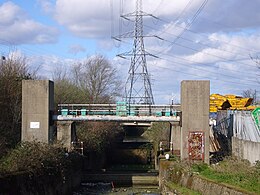Carpenter's Road Lock

Carpenter's Road Lock, seen from Marshgate Lane, before the construction of the Olympic Park
|
|
| Waterway | Bow Back Rivers |
|---|---|
| County |
Newham Greater London |
| Maintained by | Canal and River Trust |
| Operation | automatic (original) |
| First built | 1934 |
| Length | 92 feet (28 m) |
| Width | 20 feet (6.1 m) |
| Fall | was tidal |
| Coordinates | 51°32′30″N 0°00′59″W / 51.541774°N 0.016437°WCoordinates: 51°32′30″N 0°00′59″W / 51.541774°N 0.016437°W |
Carpenter's Road Lock is a rising radial lock in the London Borough of Newham, near Marshgate Lane in Stratford, England. It is located on the Bow Back Rivers and was constructed in 1933/34. It is the only lock in Britain with rising radial gates at both ends. British Waterways were hoping to restore it as part of the upgrade to Bow Back Rivers which took place for the London 2012 Games, but the gantries which enabled the gates to be raised were demolished to accommodate a wide bridge giving access to the main stadium. After the games, most of the overbridge was removed. Funding for the restoration of the lock was in place by early 2016, and it is expected to be brought back into use in 2017.
The Bow Back Rivers are a network of channels, which although they form a link between the River Lea and the River Thames, were never officially a part of the Lee Navigation. They were used commercially for navigation, but no tolls could be collected and there was no incentive to the trustees or conservators of the Lea to spend any money on their maintenance. Most of the channels had at various times been associated with water mills, and also formed an essential part of the flood relief system of the River Lea, but by the 1920s, they posed a flood risk to the surrounding area as they became choked. At the time, there were high rates of unemployment in the West Ham area, and the government had recently introduced an unemployment relief scheme. West Ham Corporation, working with the Lee Conservancy Board, applied for and received grants to enable major improvements to be carried out to the Bow Back Rivers. The work was authorised by the granting of an Act of Parliament, the River Lee (Flood Relief) Act 1930.
The work included dredging and reconfiguration of most of the channels, a new lock at Bow, rebuilding of Marshgate Lock on a new site further to the east, and the construction of a new lock at Carpenter's Road, at the northern end of the City Mills River. The whole project took around four years to complete, with work starting in 1931. Work on the lock itself, which was 92 feet (28 m) long and 20 feet (6.1 m) wide, began in 1933, and it was completed in 1934. It was built with rising radial gates at both ends. The use of rising radial gates was fairly common in continental Europe, but Carpenter's Road was the first use of them in Britain. The choice was dictated by the fact that the structure had to act both as a navigation lock and as a means of discharging flood water. It also had to be able to cope with variable water levels in both the City Mills River to the south, and the tidal Waterworks River to the north, where either one could be higher than the other. It was therefore built with two rising radial gates, one at each end.
...
Wikipedia
